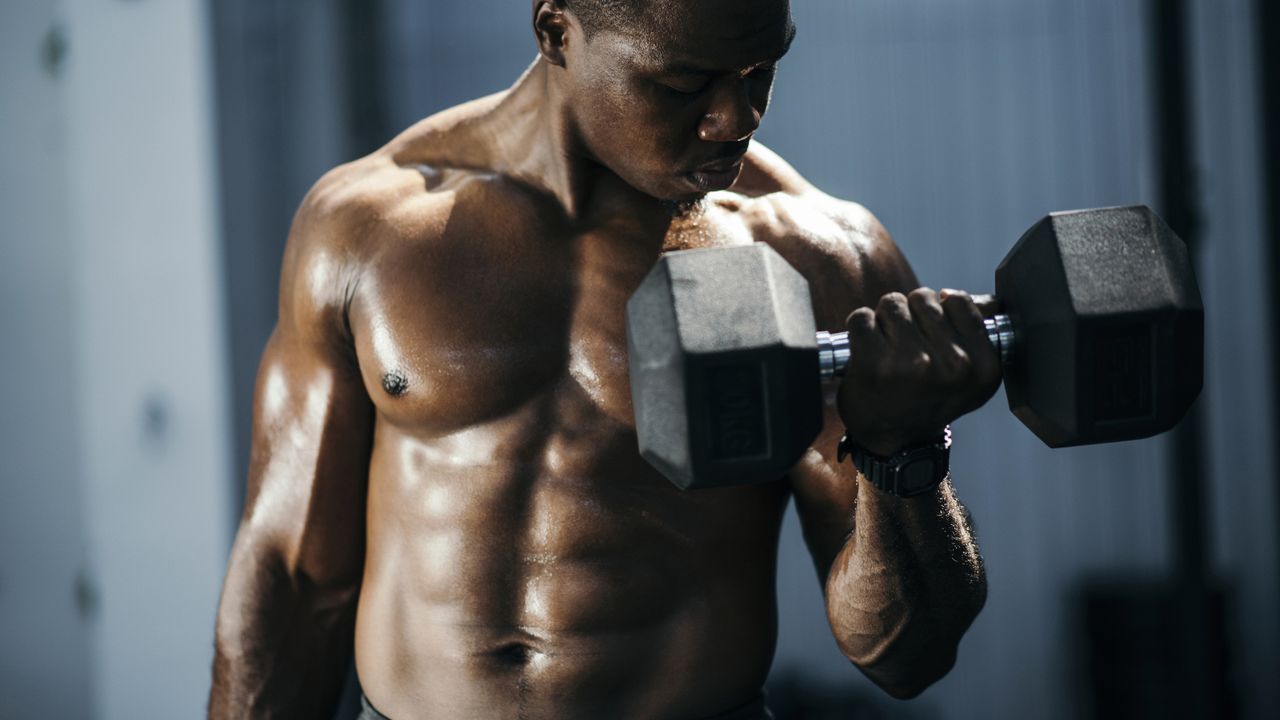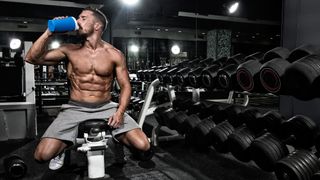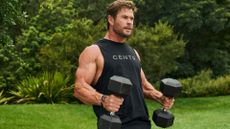

The muscle-building process is not overcomplicated, but it's also not as simple as 'lift weights = build muscle'. We did some research, crunched the numbers, tried and tested a bunch of different approaches and came up with this 5-step muscle-building guide that will surely get everyone shredded.
The issue with muscle building is that the more you read about it, seemingly the more complex it gets. Some say a couple of push-pull-legs workout sessions a week are enough, while others will recommend doing full-body workouts every day. The same goes for the importance of rest, protein intake/diet, weights, type of workouts etc.
Natural muscle building requires hard work and persistence, and the truth is, it is a personal experience for everyone. The best you can do is listen to your body and adapt a workout approach that suits you the most. Muscle building is a learning process and one that takes a bit of time to master. However, using this simple guide might help you achieve results sooner.
Build muscle effectively: an easy 5-step guide
Increasing muscle mass naturally will admittedly take some time and it will take longer for some people than for others. How fast you will pack on muscle mass depends on your age, sex, testosterone levels and more.
That said, it's a common misconception that muscle building after a certain age is a waste of time: "research demonstrates that resistance exercise training has profound effects on the musculoskeletal system, contributes to the maintenance of functional abilities, and prevents osteoporosis, sarcopenia, lower-back pain, and other disabilities", a 2001 study concludes.
You can get fit over 40 or 50 (or at any age) as long as you move around more and pay attention to what you eat and how much you rest.

Step #1: Eat your protein
A hotly debated topic is how much protein should you take to build muscle effectively. The consensus now says that for someone actively working out, the appropriate amount of protein is around 1.6-2 grams of protein per body kilogram per day. For a 70 kg (155 lbs) person, this means supplying your body with at least 112-140 grams of protein per day.
Sign up to the T3 newsletter for smarter living straight to your inbox
Get all the latest news, reviews, deals and buying guides on gorgeous tech, home and active products from the T3 experts
You should supply protein from various sources such as lean meat, eggs, nuts, leafy veg (e.g. kale, spinach), fish, tofu, legumes etc. 100 grams of chicken breast contains around 30 grams of protein, but even kale has over 4 grams in it per 100 grams.
Do you need protein powder to build muscle? The short answer is no. You don't need protein shakes, but covering your protein needs by drinking a quick protein shake or having a protein bar after the workouts is more convenient than stomaching a can of black beans.
Step #2: Supplement your muscle building efforts
Most nutritionists agree that creatine is the only supplement you need to aid muscle building. Creatine is one of the most scrutinised supplements, and it can help improve performance in the gym. One research concluded that "one week of creatine supplementation (25 g/day) enhances muscular performance during repeated sets of bench press and jump squat exercise."
And creatine does this without any side effects, even long-term. Better still, you only need a small amount each day to enjoy the benefits of creatine. After a 'loading period' – during which you saturate your body with creatine – you will only need to take roughly 3-5 grams a day. You can mix creatine with anything as it has no after taste; you can drink it with water or even your protein shake.
If you are one of those people who struggle to put on weight, consider taking the mass gainer supplements: these powders are high in protein and carbohydrates and can help you cram in some extra calories into your diet.

Step #3: Follow a progressive overload workout pattern
Progressive overload is key to muscle growth. It means you need to gradually increase the workout volume over time so your muscles will continue to grow. You can do this by using heavier weights, doing more sets/reps and increasing workout frequency.
This doesn't mean you'll need to adjust all of the above for each workout. By trying to over-optimise workouts, you'll most likely end up not pushing yourself hard enough and under-stimulating the muscles. Always listen to your body and accept that your performance will fluctuate over time.
Reassessment of the workout should be done periodically and not every day with an ample amount of variety applied to your daily workouts in between. No need to change weights every single time you do a workout but once the resistance feels less demanding, increase the weights and change the exercises.

Step #4: Mix up your workout routine
Admittedly, a progressive overload pattern can't be sustained forever. Eventually, everyone will reach a point where adding more weight to workouts will be impossible.
Even worse, if people follow the same workout pattern for more extended periods, the body will get used to the type of training/resistance, and it can even become 'immune' to workouts.
To get out of the muscle-building rut, athletes must introduce a new type of stimulus now and then. This could be anything from performing exercises differently to trying new workouts, such as powerlifting or even CrossFit. Depending on the person's fitness level, switching to a new workout routine is recommended every 1-4 months.
Workout challenges are also an excellent way to freshen up your workout routine. The 10,000-swing kettlebell or the 100 pull-ups a day challenges overload specific muscles while allowing others to rest.
We recommend trying out new techniques for those keen beans that really can't be bothered to do anything else but lift heavy weights in the gym; lifting weights slower or faster might be enough of a change to carry on building muscle. Read more about the 1-10 method and the shocking principle in Arnold Schwarzenegger's Blueprint to Mass plan.

Step #5: Choose the right exercises for muscle growth
Sure, you will want to get bigger arms but forget about doing bicep curls only when you are in the gym. The type of exercises you'll need to include more of in your workout regime are compound exercises. Deadlifts and overhead presses are good examples of weighted compound exercises, while push-ups and pull-ups are the best bodyweight workouts. Doing compound exercises will make you stronger and increase muscle coordination. You can even create workouts based on compound exercises.
Step #5: Find the right balance between rest and injury
Above is the video of the man himself, Arnold Schwarzenegger, an icon and bodybuilding aficionado in his prime. In the video, Arnold talks about getting ready for competitions and how much training they did months before the competition. He says pro muscle builders would spend four hours a day in the gym in order to pack on extra muscle mass.
Elite CrossFit athletes are also famous for training a lot: in his heyday, Rich Froning used to work out 18 times a week. This goes against everything you might have read about muscle building but you must admit that top CrossFit people look pretty shredded, right?
One thing is for sure: resting is paramount for muscle growth. Your muscles don't grow in the gym, they grow when you rest in between workouts. During resistance training, microscopic tears appear on your muscles and your body patch these up using protein (simplifying the process here).
Another thing to keep in mind is that rest doesn't always mean not working out. You want to rest the muscles so they have time to recover but you also want to work them hard enough so they'll grow. Exercise often and rigorously, especially if you have a fast metabolism, and listen to your body.

Matt Kollat is a journalist and content creator who works for T3.com and its magazine counterpart as an Active Editor. His areas of expertise include wearables, drones, fitness equipment, nutrition and outdoor gear. He joined T3 in 2019. His byline appears in several publications, including Techradar and Fit&Well, and more. Matt also collaborated with other content creators (e.g. Garage Gym Reviews) and judged many awards, such as the European Specialist Sports Nutrition Alliance's ESSNawards. When he isn't working out, running or cycling, you'll find him roaming the countryside and trying out new podcasting and content creation equipment.
-
 Chris Hemsworth’s personal trainer shares a simple dumbbell workout to build massive arm muscles
Chris Hemsworth’s personal trainer shares a simple dumbbell workout to build massive arm musclesThis six-move workout from Celebrity trainer, Luke Zocchi, will add serious muscle to your biceps and triceps
By Bryony Firth-Bernard Published
-
 Say goodbye to baggage fees – Roka's new collection is the travel hack of the summer
Say goodbye to baggage fees – Roka's new collection is the travel hack of the summerIntroducing the Gatwick collection...
By Lizzie Wilmot Published